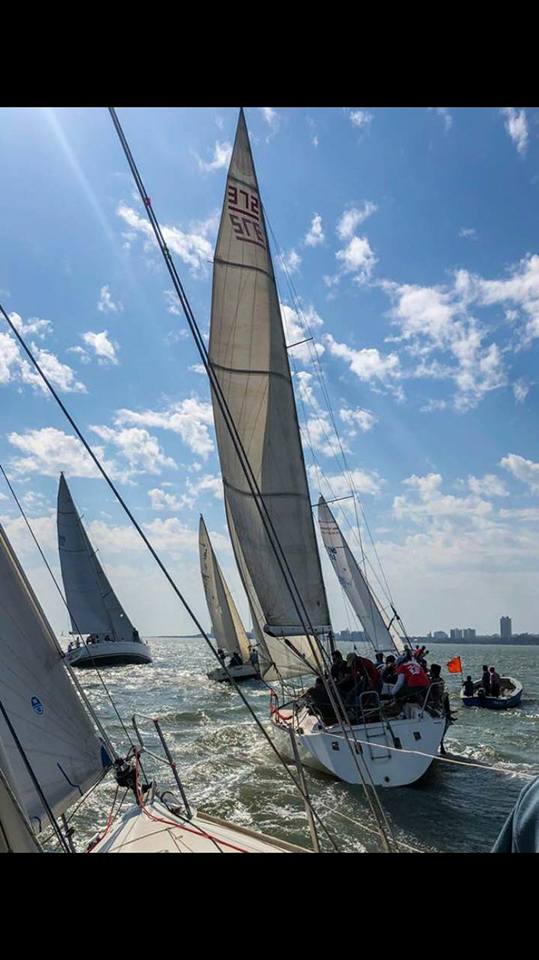I got my first taste of sailing a few months after I’d seen the ocean for the first time. It was an amazing experience – the sight of the blue sky and bluer water, the wind in my face, the thrill of the yacht tilting…I was hooked!…though I didn’t get a chance to sail again until years later. At the time, I had not even started my studies of finance and investments; I eventually built a career in investment consulting.
A couple of weeks ago, about 20 years after I first experienced sailing and investments, I participated in a longer-than-usual race – from Mumbai to Murud and back – that gave me time to reflect on how sailing and investing were similar in a lot of ways. Here’s what I got reminded of –

‘A ship in harbour is safe, but that is not what ships are built for’
This quote means that we need to get out of our comfort zone to achieve what we are meant to. A decent sized yacht doesn’t capsize easily; its keel keeps it from overturning. It’s up to the helm and crew to take it out into the open seas.
Similarly, we need to take some risks with our investments to achieve our investments. Our keel is the time we have…if we start early enough. We have 30-40 years of earnings – long enough to withstand some years of turbulence. Of course, we can save in safe harbour of bank deposits and cash mutual funds but then we won’t get good returns and achieve our potential.

Yachts have handicaps, but you can get a champion crew
Yachts can be made faster through better design, lighter materials etc. so racing organizers apply handicaps to make the races more competitive. I was on such a ‘racing machine’ so even though we got line honours on both legs, our adjusted times meant that we finished closer to the bottom of the table. On the other hand, some of the slower yachts had very experienced helm and crew – some of them Asian champions, some Olympians – that don’t affect the handicaps, yet made a huge difference to their performance. As we debriefed later, we realised we were carrying a lot of unnecessary weight – our generator and life-raft didn’t come fitted with the yacht so weren’t included in the handicap, each of the 10 crew had a 5kg backpack, we wanted the beers but weren’t going to read the manuals lying in the cabin.
In investing, we may well have some handicaps such as not being knowledgable enough, or not being able to access certain asset classes. But we can make up for these by surrounding yourself with a champion crew of a good financial adviser, a good accountant (for tax planning), a good lawyer (for wealth protection), and some good funds that add value, especially in down markets. We can ensure we don’t add unnecessary complexity to our portfolios by having funds with similar styles or high costs.

Chart the course taking into account winds and tides
The direction and strength of the winds and tides are different each day; the team has to adjust its strategy and tactics depending on the weather. The storms tend to be rougher near the shore. The winds can change very quickly, providing ‘headers’ or ‘lifts’ – or just dying down such that you’re hardly moving.
Similarly, we must plan our investment strategy depending on the longer-term inflation and growth environment, and adjust our tactics based on the shorter-term market volatility.
In upwind, you balance tacking and charting shortest course; in a downwind, competitors catch up with you
Sailing upwind means the yacht sails into the wind at an angle. Hence, we have to tack to reach the destination. The helm has to balance the number of tacks, which can cost time, and the shortest course to cover. This is the leg in which the skill of the team is tested. When sailing downwind, everyone puts up their largest spinnaker to catch as much of the tailwind as possible; someone with a larger spinnaker can catch up with a better team.
Chances are you will face both bull-run periods in which your portfolio has a ‘tailwind’ of fantastic market returns, and bear markets in which you face ‘headwinds’. In a bull run, when the price of every asset class or stock is going up, everyone around you looks like a genius. Your friends will boast about how much money they’re making in the market (or bitcoin!); some might even leverage and make more than you do.
Your skill as an investor will be tested in the bear markets when you have to balance making asset allocation adjustments with staying invested.


Racing means getting around fishnets and other ships the fastest
The course is littered with hurdles like fishnets and other ships. The foredeck crew has to keep a lookout for pairs of little flags that signal fishnets and inform the helm as far in advance as possible. I must admit I was struggling with this task; I kept wondering why I couldn’t spot that little speck on the horizon until after many others in spite of having perfect vision. I realised your eyes get trained over time once you know what to look for. Once we didn’t spot a fishnet in time and had to sail over it. Other yachts followed us, but their keels were shaped differently so got caught in the nets. Another time, we signaled to a ship that we had right of way but when it didn’t change course, we had to.
You face many hurdles in investing too. You need to train your eyes to keep a lookout. Having lived through the bond markets of 1994, Asian crisis of 1997, dotcom bubble and bust of 2000/01, and global bull-run and financial crisis of 2007/08, I am now much more careful in the bull-run and bitcoin mania of 2017. Sometimes market participants don’t follow the rules but if you’ve seen the Madoff and Satyam scams, you are more likely to spot financial shenanigans when returns look too good to be true.
Mind the boom and know the ‘Man Overboard’ procedure
The first thing everyone gets told when they step on a yacht is to mind the boom. The boom is the horizontal metal rod attached to the vertical mast; it swings from side to side, usually during a tack or gybe when everyone’s been warned. However, there are accidental gybes, which means the boom can swing across without warning. So boom is the sound it will make as it hits the head of anyone standing in the wrong position at the wrong time. If someone does get hit, or just slips and falls overboard, the crew has to swing into action very quickly to recover the ‘man overboard’.
Sometimes, you could do everything right and still be hit by something completely unexpected – a fraud, a black swan event, a personal crisis, a war or natural disaster – just because you were at the wrong place at the wrong time. You can’t plan for these. All you can do is to have a routine to recover from the calamity. I know of people who have their whole net worth in their own house; even if they weren’t affected real estate market swings, they haven’t thought through how they would recover if there were a natural disaster that the insurance (if they had indeed insured) doesn’t cover.
As I look at the pictures of my years in sailing, I remember the fun. I also think up some business and life lessons. Time will tell if I learnt those lessons.
The images are not from the particular race mentioned.
Cover image source – Bombay Merchants Cup facebook page; others – authors’ own





You must be logged in to post a comment.